The best fishing weights: how to pick the right sinker
Selecting the best fishing weights for the job from the various different types available is vital for success on the water
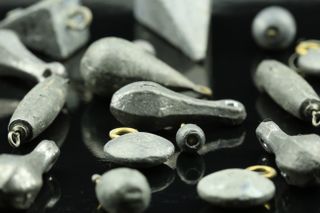
If you want to know your sputniks from the cannonballs and your torpedos from your pyramids, this in–depth guide to choosing the best fishing weights is for you.
A sinker – a general term for a weight attached to your line – forms a vital part of your overall set–up in any fishing trip, so choosing the best fishing weight for the task at hand is vital. It's up there with choosing the best fishing line, rod, reel and hook in terms of its importance to your overall success.
In this article, we’re going to learn about what types of sinker there are available – from bullet weights and cannonballs, to sputniks and pyramids – and when best to use them to maximise your fishing success. We’ll also lay out some general principles about selecting the best fishing weights for the target species and conditions you’re facing. Armed with this expert knowledge, you'll be well equipped to choose the best fishing weight for whatever fishing you're doing.
The best fishing weights: What is a sinker?
Often made from lead, a sinker is used to help the rig sink and provides a casting weight so you can propel the rig further. In addition, the sinker holds your rig in position in whatever environment you may be fishing, whether it’s on a calm lake or the open ocean, boat or shore.
But use too small a lead and your rig will not reach where it's meant to on the cast, or it won't sink fast enough or hold bottom in current. Too big a sinker and you may break your rod or line, lose fish and miss bites. These are all factors that play into choosing the best fishing weight and we'll discuss each in detail.
A sinker is usually made from moulded lead and has a small metal loop or swivel to thread the line through, or a hole through the centre for the same purpose. Sinkers can also be coated – for attractant or camouflage effects. Some can also be made from tungsten or steel but lead is by far the most common type of sinker material.
Generally, sizes range from fractions of an ounce for light line fishing and small fish rigs, up to several pounds for dropping rigs in deep ocean. More usually, sinkers in the 0.5–8oz category cover most of what the average angler will use in fresh or saltwater.
Advnture Newsletter
All the latest inspiration, tips and guides to help you plan your next Advnture!
How to choose the best fishing weight: the two big factors to consider when selecting the right sinker
Choosing the best fishing sinker is largely based on two factors. What environment are you fishing in? And what presentation (bait and rig) are you trying to present to the target fish?
Let’s explore these two questions, then look at what the best sinker choice might be in some common situations and why this selection has been made.
First, what environment are you fishing in: are you fishing on a boat or on land? How deep is it there? What does the structure (docks, weed, old tree stumps, sand bars, debris etc) look like where you are fishing? Is it rocky? Is it smooth? Is there grass or kelp that can hang you up? How fast is the water moving if it’s a river or in the ocean?
Second, what presentation are you trying to show the target fish: where is the target fish typically found in the water column (surface, bottom, mid-water)? How do you rig up to catch that fish? Are you trying to tether your bait to a spot, or do you want it to drift? Do you want to sink all the way to the bottom, or do you want to stay suspended in the water column?
By answering these questions, you’ll give yourself some big clues when it comes to selecting the best fishing weight for the sort of fishing you’re doing. It might be a tiny 1/16oz sinker for trout fishing off the dock, or a giant 10lb weight for deep drop fishing in hundreds of feet of ocean.
Now you've seen the sort of criteria you should be using and the thought processes around the best fishing weight selection, let's break each area down into bite–size chunks with some real–world answers.
How to choose the best fishing weight: selecting the best size of sinker
But before we look at some different situations, let’s talk about how to choose the best size of fishing sinker to use. Beginner anglers tend to use more weight than they really need. Often, the reason behind this trend is that more weight tends to be easier to cast for someone starting out.
One problem with using too much weight, is that it will go through the water column faster than what may be the optimal rate to attract and catch fish. If you're looking to target a species that's off the bottom, maybe you're lure fishing for trout or bass, you need to keep this in mind so your bait or lure is in the same zone as the fish. It’ll also crash into the water with more disturbance - an important consideration when freshwater fishing in a small pond or river, for example
Even if the target fish is bottom oriented – like a catfish, flounder or ray – you can still go too heavy. Big sinkers dig into the bottom, causing poor bite indication and missed fish. Finding a balance between too heavy and too light is important and will come with a some experimentation and thought as to how your rig and sinker is performing.
Too heavy of a weight might overload your rod to breaking point, or may be difficult to retrieve. Ideally, you’ll want to have different weights and sizes of the preferred style of weight so you can find that balance and adjust if you need to, as conditions change on the water.
Ultimately, it’s down to your judgement to work out the best fishing weight to fit your needs on the day - it’ll soon be obvious that you’re fishing too heavy or light if you take into account the above guidance. A minor adjustment one way or the other – heavier or lighter; 1oz to 1.5oz, for example – is often all that’s needed.
A good tip is to check out the weight rating on your favored rod or pole – it’s often printed on the rod near the handle end. Most will give you an idea in ounces or grams about what sort of sinker weight is going to work best and it’s important to not overload the rod. Likewise, choose too small a sinker and the rod won’t cast properly as the action is too stiff to compress under the smaller weight.
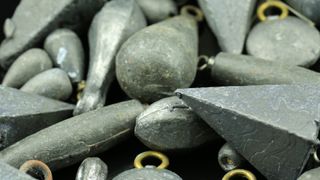
How to choose the best fishing weight: common types of fishing sinkers, rigs and applications
Next, we’ll run through the different types of sinker available to buy, what rigs to use and when to use them for maximum success. Whilst there may appear to be hundreds of different types of sinker on the market, there are a handful of main ones to know about and use. Armed with these and our expert's guidance, you’ll be able to tackle almost any fishing scenario you could face.
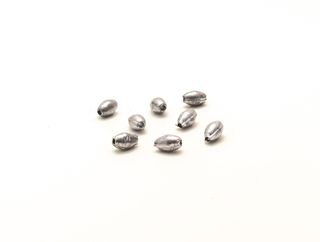
How to choose the best fishing weight: When to use an egg sinker or bullet weight
This type of sinker is used in a variety of rigs for a wide variety of fish species and it’s a great all-rounder. The sinker is either shaped like an egg or a bullet, with a hole through the centre of the long axis of the shape. They can be used pretty interchangeably, although the bullet-shaped one may offer a small advantage in terms of getting snagged in weeds, be it seaweed on the shore, or grass in a lake.
One application is for light line surf fishing and it’s commonly used as part of a Carolina Rig set–up for use anywhere on any coastline to catch a variety of species from the shore. The “C-rig” is a common set–up with numerous other applications like largemouth bass fishing, trout fishing and catfish fishing too.
It’s easy to set up and very effective, consisting of the sinker threaded onto the main line, a swivel and leader line with hook attached. A bead is threaded between the weight and the swivel to protect the knot. It's a great all–rounder.
For light line surf fishing, for example, typically start with a 0.5oz / 14gr size and adjust up to 1.5oz / 43gr depending on the depth of water, current and tidal movement. A similar starting point weight-wise is recommended for most light-action combos, freshwater or salt. Obviously, a smaller sinker won't cast as far as a larger one, so keep this in mind. If you can't cast where you see fish feeding, you may need a bigger sinker.
Egg sinkers can also come in much larger sizes and these are useful if you want a heavily-weighted rig that needs to hit the bottom in deep, calm water. Maybe you’re catfish fishing in a deep lake, dropping big baits for grouper in the ocean or weighting a big bobber – an egg-style sinker is useful in all these scenarios.
How to choose the best fishing weight: When to use a pyramid sinker or sputnik (surf) sinker
As you might have guessed, one of these sinkers is shaped like a pyramid. It has a metal loop to attach your line on what you would consider to be the flat bottom or underside of the pyramid.
This kind of sinker is used in situations where you are trying to tether your presentation to a certain spot. Because of its shape, it excels in digging into a sandy or muddy bottom to hold your bait in situ, but it may get hung up too often if the bottom is rocky or snaggy.
The sputnik is named after the Russian satellite of 1960’s Space Race fame because the lead is shaped like a torpedo sinker, but with distinct wire attachments. The first is a wire stem that protrudes from the top of the sinker, terminating in a small loop to attach your line. Then there are four wire “legs” sticking out and up from the bottom of the lead, like an old-fashioned satellite.
The legs dig deep into sandy or muddy bottoms and hold fast, but the wires bend out under pressure from the angler retrieving or fish biting. If you need that extra degree of bottom stickiness – in large surf and heavy currents, for example – the sputnik is your first choice if the pyramid isn’t holding and going heavier isn’t an option.
A common application for pyramid or sputnik sinkers is when targeting larger species from the beach when surf fishing or in fast-flowing rivers. Usually the bait involved will be a whole or chunked bait fish (mackerel, sardine, herring) or squid to attract a larger predator like a shark. There are a number of different ways to set up this kind of rig (a pulley rig or Carolina rig is most common) but, with all, the pyramid or sputnik shape helps hold that bait to a spot so the predator can find it. These are your best choice of sinkers for fishing in heavy current, surf or pier fishing.
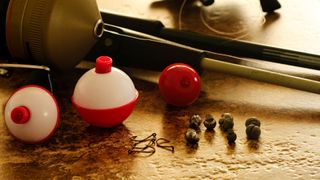
How to choose the best fishing weight: When to use a split shot fishing sinker
A split shot fishing sinker is a small ball-shaped sinker with a slot in one side. You position your line in the slot and clamp the sinker onto the line by pinching the weight so it grips onto the line.
Often, split shot weights are the smallest sinkers you can buy and they’re useful for when you don’t have to cast far or drop a bait in deep water, but still need some weight on the line, maybe to slowly sink a bait like a nightcrawler or a small grub.
Originally, split shot weights were made from shotgun shot, with a slot simply cut in the larger sizes of shot to modify them for fishing purposes. But they’re specially manufactured now for fishing with the only disadvantage being the ease at which wildfowl will consume and become poisoned by lead shot, so dispose of your rigs and weights safely, or choose a non–toxic alternative.
Split shot are also useful for weighting small bobbers and they often come in handy round dispensers containing a variety of small sizes. Just be careful not to damage the line when clamping them on – don’t squeeze them with pliers or your teeth!
These are your best choice of fishing sinker for tackling a pond, lake or river for smaller species such as panfish, trout or perch. You can't cast a small splitshot very far but they are great for any situation where this doesn't matter. Overall, a wise option for anyone needing small sinkers for simple freshwater fishing.
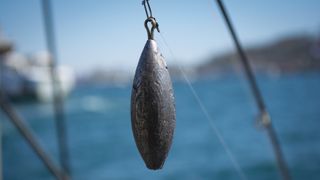
How to choose the best fishing weight: when to use a casting or bomb shape sinker
A casting or bomb sinker has a pear or torpedo-shaped body with a wire loop or swivel protruding from the top. The aerodynamic shape of the casting sinker and versatility of the rounder bomb-style weight make them two great all-round options for a variety of rigs.
The shape makes them ideal for casting a good distance but they’re not great at holding a bait in place in any sort of current, unlike the pyramid or Sputnik sinker. Keep this in mind when you're choosing the best sinker for the job.
But, this style of sinker is popular for a lot of freshwater fishing and is commonly used when targeting species like carp, catfish, trout and bass, often with a more static bait-based approach when casting distance is the most important factor.
The rounder bomb-style of sinker is also useful when bouncing baits down the current; when you need a certain amount of weight to cast and hold the bait down, but you want it to be moving naturally down with the current. The rounded shape doesn’t dig into the bottom like a pyramid sinker might. This is ideal for some salmon and trout fishing techniques – “flossing” for steelhead in the North West, for example.
This style of sinker is also called a bank sinker but it’s best to buy the slightly more expensive type with a metal loop or swivel on the top. Lots of retailers sell variety packs of casting sinkers and a small range covering 0.5–2oz / 14–57g will serve any angler well for most of their fishing.
How to choose the best fishing weight: when to use a torpedo fishing sinker
A torpedo sinker is similar to a bomb or casting sinker but it has a small wire loop at either end and a slimmer, longer shape. This is useful for dropping baits in deep water in the ocean, for example, when you want a hydrodynamic sinker that sinks quickly and offers little resistance when retrieving up through the water.
Common applications include fishing live and cut baits for tuna, rockfish, grouper and snapper at a certain depth when you don't need to hold bottom. A typical example might be when you're fishing from a boat and see fish showing a half–depth on a fish finder. A torpedo sinker sinks fast to the desired depth and will hold there better than other less hydrodynamic designs that tend to rise in the water easily, making this style the best choice of weight for the job.
A torpedo-style sinker is also used when trolling, which involves towing a lure or bait behind a moving boat to attract predatory species such as muskie, large trout, salmon, lake trout, tuna, sailfish, wahoo, mahi mahi and marlin. The main line can be attached to one loop, the leader to the other loop, and it helps the lure or bait run deeper in the water column, away from the surface and in the strike zone.
How to choose the best fishing weight: cannonball, deep drop, drop shot, pack bait, method and feeder sinkers
As with many things fishing-related, each sub-category of the sport has its own favored sinker designs and there are hundreds of variations, often designed for specific local applications. These are useful to keep in mind.
For example, a large cannonball-shape weight is often used for trolling on a set-up known as a downrigger. This enables a relatively light combo to be fished at a great depth as the downrigger – which consists of a winch, heavy line and ball weighing several pounds – removes the need for a huge sinker and heavy gear. The main line is held by a clip near the cannonball sinker that’s secure until a fish is hooked, whereupon it’s released from the downrigger and you’re direct to the fish on your lighter combo.
Deep drop fishing, where you target deep-water species in several hundreds of feet of water, is also increasingly popular and a large cylindrical sinker weighing several pounds is used for this, often with a large electrically-powered reel to make retrieving the hefty set-up less choresome.
At the other end of the scale, small cylindrical sinkers weighing less than an ounce that skate across the bottom easily are used for a style of lure angling called drop shot fishing. A small lure and single hook is tied onto the main line with the sinker a few inches or feet below the lure on the main line, so the sinker is the first thing on line, where you might normally find the hook. This enables the lure to be worked up in the water without it sinking, and the special weight doesn’t get snagged or hung up easily.
Often, anglers targeting carp and catfish use a sinker with a little wire cage or protrusions build around it. This is so that the packbait – a glutenous mix of various cereals and powdered enticements made into a sticky, mouldable lump that dissolves to attract fish – can be moulded securely around the wire cage for casting without the packabit falling off. The wires or nodules help the packbait grip the sinker but still disperse when exposed to water. This type of sinker is sometimes called a swim feeder, method feeder or packbait sinker and is popular in Europe for all sorts of freshwater fish.
Now you're ready to choose the best fishing weights for your fishing
Now we’ve run through all the different types of sinker available and the applications for each, you’ll be able to match your sinker selection to the conditions, wherever you may be fishing.
Each has its own advantages and disadvantages - it’s up to you to consider the factors involved, as outlined above, and make a choice to maximise your chances of success. Experience is a great help in this respect but trial and error is a great way of gaining the experience necessary to choose the best fishing sinker for the job.
Joe Sarmiento is the founder and primary writer for the So Cal Salty blog, covering the many saltwater fishing opportunities found year-round in California and Mexican waters. In addition, Joe’s writing has appeared on BD Outdoors, Western Outdoor News, and The Log. As much as Joe enjoys fishing, he also enjoys cooking and eating his catch – you will find many recipes for various saltwater species like yellowtail, tuna, rockfish and lingcod included in his work.
Most Popular

